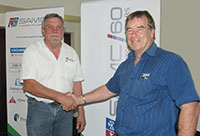
Tony Rayner, Trabtech product manager, delivered an interesting and comprehensive presentation on surge protection at the Durban branch September technology evening, discussing Lightning Electromagnetic Pulse (LEMP) due, of course, to lightning(!) and Switching Electromagnetic Pulse (SEMP) surges, due to power utility switching, inductive loads (eg motors), defective electrical devices etc.

He emphasised the key principle that surge protection is not the same as voltage regulation – surge protection devices (SPD) - cover short durations from micro second to pico second.
Lightning formation is now well understood – violent updrafts and downdrafts in storm clouds result in the separation of positively and negatively charged ice particles which can create voltage differences between cloud base and ground of as much as 100 million volts. This potential difference causes ionisation of the air and formation of plasma paths which are a precursor to the lightning strikes. Some interesting characteristics of lightning are: voltages between 108 V and 109 V; currents of 300 kA to 800 kA; core temperatures of the plasma at 300 000°C; strike speed of 150 000 km/sec!
He showed some interesting photographs and video footage of lightning formation and strikes to ground, including blowing a wheel off a 737 jetliner(!), damaged masonry and a destroyed wind turbine. Also a humorous video of a lady’s jersey igniting the fuel filler of her car through static electricity discharge!
He moved on to how we can protect our electrical and electronic devices. Three surge protection device classes are defined from two characteristic waveforms – an 8/20 microsecond (rise/duration) waveform falling under IEC Classes I and II, and a 10/350 waveform falling under IEC Class I.
• SPD Class 1 (for lightning protection and usually installed at the main incomer level: technology is typically a spark gap such as gas discharge tube).
• SPD Class 2 (for switching protection and usually installed at the main DB level: technology is typically a metal oxide varistor).
• SPD Class 3 (for device protection and usually installed at the device: technologies are typically varistor and avalanche diode).
It is generally recommended for best protection to use a combined Class 1 and Class 2 SPD arrangement.
Tony’s parting shot: “Protection against lightning is not a dark art. Reputable manufacturers are effectively able to protect against lightning and surges.”
Thanks Tony for supporting the Durban branch and delivering a most interesting talk.
| Tel: | +27 11 312 2445 |
| Email: | [email protected] |
| www: | www.saimc.co.za |
| Articles: | More information and articles about SAIMC |

© Technews Publishing (Pty) Ltd | All Rights Reserved